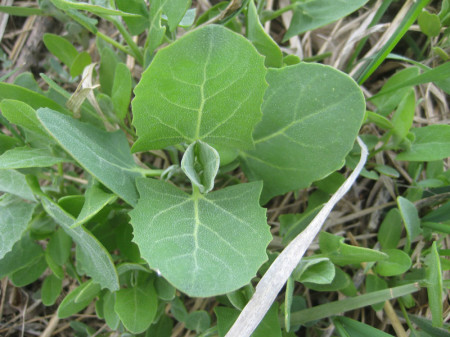
One of my absolute favorite wild veggies is orache, an herbaceous, annual member of the genus Atriplex that grows in the alkaline soil of Denver, Colorado and surrounding areas. Oraches are salt-loving plants, so in addition to salt playas in landlocked regions, species can also be found along coastlines and even along roadsides where the soil or sand is saline.
Orache looks a lot like the edible wild spinach “goosefoot” or “lamb’s quarters” (Chenopodium album and related), so much so that when I posted a Facebook picture of the orache I was eating along with a caption that said “orache,” more than one person commented how much they liked lamb’s quarters!
Both orache and lamb’s quarters have green to greenish-blue leaves that are covered, particularly on the underside and growing tips, with a white, mealy substance upon which water balls up and runs off. Like those of the goosefoots, the flowers that come later don’t look much like flowers at all, but rather small clumps clustered on the upper parts of the stems.
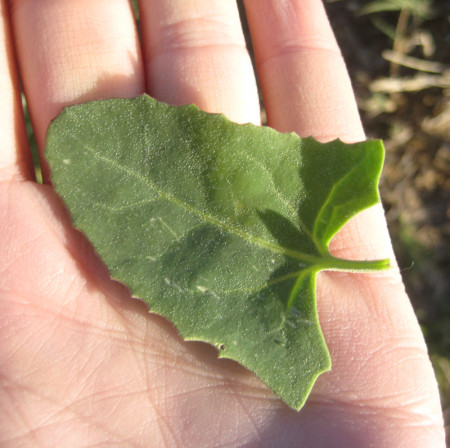
The leaves of most species of orache differ in shape from lamb’s quarters, however, tending towards arrow- or triangle-shaped. Botanists describe this characteristic as “hastate,” meaning “shaped like an arrowhead, with narrow basal lobes standing out at wide angles” (Flora of the Great Plains, 1986), such that the bases are straighter or even indented as opposed to the rounded or diamond-shaped leaf bases of goosefoot. In Stalking the Blue-Eyed Scallop (1964), Euell Gibbons describes the leaves of common orache (Atriplex patula) on the Maine seacoast as “somewhat halberd-shaped … except that the two barbs on the lower edges are turned outward instead of pointing downward.”
Keep in mind, however, that orache leaves can be variable. The leaves of common orache (Atriplex patula) range from triangular or arrowhead-shaped to lance-shaped or linear. They are toothed, sometimes with wavy margins, and grow on petioles opposite one another in the shoot stage, with subsequent leaves higher up becoming alternate.
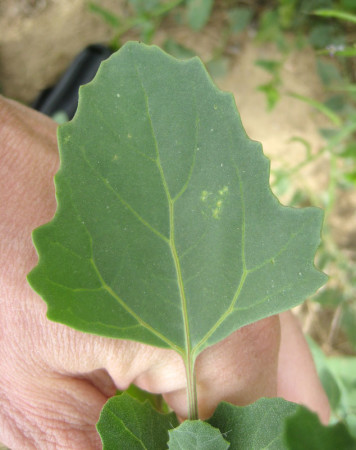
What sets orache apart from goosefoot in my opinion, however, is that the greens come pre-salted to varying degrees by nature. That’s because oraches, like their fellow desert-loving, woody Atriplex species, retain salt in their leaves. Thus one need only sauté the greens—whether young, entire spring tops or thick, late-season leaves—for a subtly salted side dish to accompany a meal or accent more complex dishes.
Salty Yum Yum
Though some foragers report orache to be bitter, others rave about its culinary virtues. Scotland forager Mark Williams at Galloway Wild Foods writes: “I rate the ones I encounter very highly—both as a superb salad leaf when young, and as a spinach substitute when mature.” The coastal species available to him include spear-leaved orache (A. prostrata or A. hastata), frosted orache (A. lacinata), and Babbingtons orache (A. glabriuscula); as well as common orache (A. patula) inland. “The tender young leaves, to my palate, are wonderfully sweet with nutty overtones and a hint of salt,” he enthuses.
On the Scotland coast, Williams notes that orache can be found on and above the high-tide line, generally growing from decomposing seaweed bands. Likewise, Gibbons (1964) describes A. patula growing just above the high water line from Labrador to Virgina, in many places “so abundant that it would be hard to find a hundred yards of shoreline without enough of this plant to furnish an excellent salad or vegetable for the camp dinner.”
Of course that was a different time, and now some Atriplex species in the northeastern U.S. are protected, with designations ranging from “endangered” to “salvage restricted,” including A. glabrisciula (CT, NY, and RI) and A. subspicata (NJ and NY), along with A. tularensis and A. coronata in California and A. hymenelytra in Arizona (http://plants.usda.gov/threat.html).
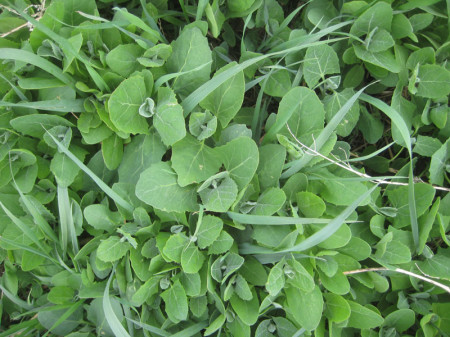
In his 2012 textbook, Survival Plants, Cattail Bob Seebeck treats Colorado’s green, triangle-leaved oraches together under the common name “saltbrush,” and recommends searching for their broad, 1-6-inch-wide arrowhead-shaped leaves on plants growing up to 4 feet tall in meadows, pastures, playas, and river bottomland with medium moist to dry soil, full sun to partial shade.
One of the most common species of orache I find in Colorado is the non-native Atriplex heterosperma, which does not present a moral dilemma to foragers. I have also found thick, lush specimens of orache that I didn’t key out in alkali flats-turned-farmland in Utah. Roadsides and ditches are also good places to look, avoiding heavily trafficked roads if you plan to eat it, of course.
Kitchen Bound
In the past, I’d been lucky to score small batches of orache here and there, mostly because I have to travel to lower elevations to find it. Seebeck (2012) reports it topping out at 9,000 feet. But finally on a foraging mission to parts we found young plants growing in abundance, and I was able to clip the tops of many plants, harvesting four leaves or so from each, while spreading out the harvest to many patches throughout the course of a day. I took home a plastic grocery bag half full, which is a lot because the fleshy leaves lay flat so that the plant material is quite dense in the bag.

The first night I made an orache-accented stir fry with leftovers from the fridge, including a batch of frozen peas once used to ice an injury, rice noodles, fried rice, and tofu cubes deep fried in oil with a splash of soy sauce. I don’t usually cook with peas, so I found them to be a nice addition. But the star of the show was the orache, of course. It is spinach-like, but with a hint of salt, and I found I needed no additional flavoring. We both ended up with squeaky “spinach teeth” during dinner, which, as with spinach, is perfectly normal.
The next day I made orache tortilla pizzas for lunch—flour tortillas painted with a light coat of olive oil on both sides and broiled until each side showed just a hint of golden brown, then spread with a thin layer of sauce, pre-pan-wilted orache (with oil and a splash of water), and grated mozzarella. Then I broiled these for a second longer until the cheese melted. I swear I could eat orache tortilla pizzas every day!
I’d write more, but I need to go figure out what other fantastic things I can make with that delicious orache in the refrigerator.
Updated 2.21.21
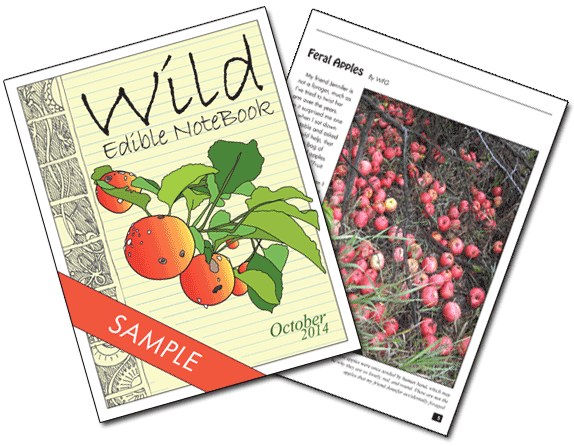
Really great, informative article
I resently found your article on ? While trying to identify Orange Currants or dock maybe , not sure now. Lol. I’m 64. I have always been interested foraging, My father taught me about minors lettuce, wild strawberry, salmon berries. Wild Blackberries vs. Himalayan and evergreen in the PNW Cascades as a kid. Since moving to the desert out of Boise Idaho, bored on a budget, I have really gotten in to foraging and teaching my granddaughters. 6&4, last week in the desert we saw a big grouping of rocks out by where I live in so we went to explore and found this wonderful little canyon with multitudes of orange currant, which to me look like green gooseberries. The orange ones were a tasty, little tart, then we found one bush out of thousands that was red and they were sweet and very tasty, had a hint of raspberry flavor. My granddaughter is excited to go back and pick more when they get riper. She’s also likes to pick the mustard tops, and enjoys eating lamb’s quarters. Freaks her mother out. Last summer we were also overran by 1,000s grasshoppers. Identified at least 10 very distinct varieties. After they ate my yard we decided we would eat them. So We kinda D vein them like you would a shrimp, put them in a bag of seasoned flour, put them in the deep fryer. The 4-year-old thought that was great and has been asking for more. Really interested in trying the Siberian elm. And have been identifying different types of Dock. As it grows everywhere out here. Thank you so much for the great quality pictures, recipes and instructions.! You take the guess work out identification.
Hi Nancy, you are most welcome! But thank you, too, for sharing this delightful story. It is wonderful what you are teaching your granddaughters. I love that you tried grasshoppers! Golden currants are so fascinating because it is one species with bushes that might have orange, red, or black/purple berries. I love the orange and red ones myself:)